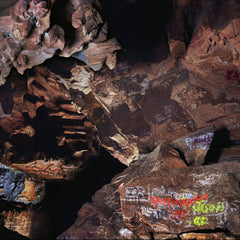yoichi kamimura // ryūhyō LP
- Availability:
※12月中旬発送開始します(プレスが遅れています)
日本のフィールドレコーディング作家上村洋一が、2025年9月にドイツ・ベルリンのフィールドレコーディングレーベルforms of minutiaeから200部限定でリリースするレコードです。
流氷をテーマにしたフィールドレコーディング10曲を収録。DLコード付属。45RPMです。
以下、レーベルによる解説です。
"国連は2025年を「国際氷河保存年」と定め、今年から毎年3月21日を「世界氷河デー」とすることを宣言した。これは、気候システムと水循環における氷河、雪、氷の重要な役割と、地球の雪氷圏の差し迫った変化が経済的、社会的、環境的に及ぼす影響について、世界的な認識を高める機会である。この決定を記念して、forms of minutiaeは、氷河と氷の音響的多重性に特化した一連のアルバムを発表する。
ルートヴィヒ・ベルガーの「crying glacier」に続く第3弾は、サウンドアーティスト/フィールドレコーディング作家上村陽一による、日本独自の流氷への繊細なダイブ・アルバム「ryūhyō」である。
4年の歳月をかけて録音されたこのアルバムは、北海道沿岸のオホーツク海で、日本の流氷「リュウヒョウ」が生み出す複雑なサウンドスケープを共有している。イタリアのベニスやオレゴン州のポートランドと同じ緯度に位置するオホーツク海は、流氷が見られる北半球最南端の地域である。このユニークな現象は、アムール川の淡水がオホーツクの海水と混ざり合って凍ることで毎年冬に形成される。蛇行した流れは広大な氷に姿を変え、海を覆い尽くす。流氷は海流に流されながら南下し、ユネスコの世界自然遺産に登録されている知床の海岸を飲み込む。流氷は栄養豊富な淡水を放出して植物プランクトンを繁殖させ、魚類、アザラシ、ワシ、クジラなど多様な野生生物を育む。しかし、この季節ごとの生態系は気候変動によって年々減少し、流氷は指数関数的に減少している。
30年前、氷は大きく厚く、地元の人々はその表面を歩いたり遊んだりすることができた。長老によると、かつて氷がオホーツク海を満たしていた頃、氷は地面のように動かなかったが、音は発していたという。人間のような口笛や息遣いが凍った水平線から発せられるのだ。地元の人々はこの現象を「流氷鳴り」と呼んでいる。2019年以来、上村洋一は毎年この音の録音を試みてきたが、今日の弱くなった流氷はもはや口笛は吹かず、代わりに新たな小声の語彙を共有している。
上村の録音のおかげで、流氷の豊かさを音で感じることができる。氷は浮遊し、互いに擦れ合い、キーキー、パチパチ、ゴボゴボと音を立てる。そこに現れるのは、濃密なテクスチャーのサウンドスケープであり、溶けゆく声の魅惑的なレンジを担っている。空中録音と水中録音をブレンドすることで、このアルバムは私たちの耳を浮遊する氷の亀裂の間に位置づける。このような狭い空間では、音は潮の満ち引きとともに、身体的、グロテスク、そして気まぐれなうねりとなって流れ、曲名にもなっている(「おなかの音」は「胃の音」を意味する)。しかし、この氷のような金切り声、いびき、うなり声だけが音による表現ではない。アルバム全体を通して、複数の動物の声が氷の上や下に響いているのだ。shima-fukurouでは、シマフクロウの亡霊のような鳴き声が凍てつくノイズの中に響く。kyuai では、氷の下の水面が不気味な鰭脚類の求愛の場となる。とらえどころのないゼニガタアザラシの鳴き声が、正弦波のダウン・スウィープで海を満たす。
ryūhyō では、上村は流氷が自らの物語を語るのに耳を傾けている。これらのレコーディングは、流氷の音の複雑さと、流氷固有の脆弱性を共有しながらも、流氷独自の生態系の豊かさを際立たせている。おそらく上村は、かつて流氷鳴りと呼ばれた奇妙な音を目撃したのだろう。時が経ち、熱を帯びて、その音は新たな声へと変化したのかもしれない。"
レーベルその他作品はこちら /// Click here to see more Forms of Minutiae releases available at Tobira.
----------------------------------------
SHIPPING FROM SEPTEMBER
Includes DL code.
12" black vinyl.
Tracklist:
1. ryūhyō 04:58
2. ibiki 03:34
3. shima-fukurou 05:09
4. mayonaka 02:36
5. yuki to kōri 01:29
6. kyūai 05:05
7. minehama 02:58
8. onaka no oto 05:08
9. kankōsen 03:43
10. haru 02:26
Text excerpt by Forms of Minutiae:
"2025 was declared the International Year of Glaciers’ Preservation by the United Nations, accompanied by the proclamation of March 21st of each year as the World Day for Glaciers starting this year. As they put it, “this is an opportunity to raise global awareness about the critical role of glaciers, snow and ice in the climate system and the hydrological cycle, and the economic, social and environmental impacts of the impending changes in the Earth’s cryosphere.” To celebrate this decision forms of minutiae presents a series of albums dedicated to glaciers and the acoustic multiplicity of the ice, with field recording works by Marc Namblard, Ludwig Berger, Yoichi Kamimura, Cheryl E. Leonard, and Pablo Diserens.
Following Ludwig Berger’s “crying glacier”, the series continues with its third album, “ryūhyō”, a delicate dive into Japan’s unique drifting ice presented here by sound artist and field recordist Yoichi Kamimura.
Recorded over four years, the album shares the intricate soundscape birthed by Ryūhyō, Japan’s drifting sea ice, in the Sea of Okhotsk by the coast of Hokkaido. Located on a similar geographical latitude as Venice (Italy) and Portland (Oregon) this is the northern hemisphere's southernmost region to see drifting sea ice. This unique phenomenon forms each winter as the Amur River’s freshwater mixes with the Okhotsk’s seawater and freezes. There, the serpentine stream morphs into a vast expanse of ice, blanketing the ocean. It descends south, carried by the currents, before engulfing the shores of Shiretoko, a UNESCO World Natural Heritage site. Here, drift ice plays a vital role in the thriving local ecology, as it releases nutrient-rich freshwater that fuels phytoplankton blooms, which in turn support a diverse range of wildlife, including fish, seals, eagles, whales, and other species. Yet, year after year, this seasonal ecosystem dwindles due to climate change, exponentially thinning Ryūhyō.
Thirty years ago, the ice was large and thick, allowing locals to walk and play on its surface. According to elders, when the ice used to fill the Sea of Okhotsk, it remained motionless like the ground, yet it made a sound. Human-like whistles and breaths would emanate from the frozen horizon, a phenomenon referred to by locals as Ryūhyō-Nari (drift ice noises). Each year since 2019, Yoichi Kamimura has attempted to record this sound, but today’s weakened drift ice no longer whistles; instead, it shares a new set of guttural vocabulary.
Thanks to Kamimura’s recordings, Ryūhyō’s richness can be felt through sound. The ice accumulates in floating imbrications that rub against one another in squealing, crackling, and gurgling utterances. What emerges is a dense textural soundscape that bears the fascinating range of these melting voices. By blending aerial and underwater recordings, the album positions our ears between the floating ice fissures. In these squeezed spaces, sounds ebb and flow with the tides in bodily, grotesque, and whimsical swells, to the point of inspiring some of the track titles (such as “onaka no oto” meaning ‘stomach rumble’). But these icy screeches, snores, and gurgles are not the only sonic expressions here. Who else inhabits Ryūhyō? Across the album, multiple animal voices echo above and below the ice. In “shima-fukurou”, the frozen noise is cadenced by the ghostly call of a Blakiston's fish owl, one of the world’s largest and rarest owls, endemic to this region. In “kyūai”, the water beneath the ice houses an uncanny pinniped courtship: elusive ribbon seals' songs filling the ocean with sinusoidal downsweeps — an otherworldliness that accentuates the peculiarity of this drifting soundscape..."
Artist : yoichi kamimura
Label : Forms of Minutiae
cat no : fom16
※12月中旬発送開始します(プレスが遅れています)
日本のフィールドレコーディング作家上村洋一が、2025年9月にドイツ・ベルリンのフィールドレコーディングレーベルforms of minutiaeから200部限定でリリースするレコードです。
流氷をテーマにしたフィールドレコーディング10曲を収録。DLコード付属。45RPMです。
以下、レーベルによる解説です。
"国連は2025年を「国際氷河保存年」と定め、今年から毎年3月21日を「世界氷河デー」とすることを宣言した。これは、気候システムと水循環における氷河、雪、氷の重要な役割と、地球の雪氷圏の差し迫った変化が経済的、社会的、環境的に及ぼす影響について、世界的な認識を高める機会である。この決定を記念して、forms of minutiaeは、氷河と氷の音響的多重性に特化した一連のアルバムを発表する。
ルートヴィヒ・ベルガーの「crying glacier」に続く第3弾は、サウンドアーティスト/フィールドレコーディング作家上村陽一による、日本独自の流氷への繊細なダイブ・アルバム「ryūhyō」である。
4年の歳月をかけて録音されたこのアルバムは、北海道沿岸のオホーツク海で、日本の流氷「リュウヒョウ」が生み出す複雑なサウンドスケープを共有している。イタリアのベニスやオレゴン州のポートランドと同じ緯度に位置するオホーツク海は、流氷が見られる北半球最南端の地域である。このユニークな現象は、アムール川の淡水がオホーツクの海水と混ざり合って凍ることで毎年冬に形成される。蛇行した流れは広大な氷に姿を変え、海を覆い尽くす。流氷は海流に流されながら南下し、ユネスコの世界自然遺産に登録されている知床の海岸を飲み込む。流氷は栄養豊富な淡水を放出して植物プランクトンを繁殖させ、魚類、アザラシ、ワシ、クジラなど多様な野生生物を育む。しかし、この季節ごとの生態系は気候変動によって年々減少し、流氷は指数関数的に減少している。
30年前、氷は大きく厚く、地元の人々はその表面を歩いたり遊んだりすることができた。長老によると、かつて氷がオホーツク海を満たしていた頃、氷は地面のように動かなかったが、音は発していたという。人間のような口笛や息遣いが凍った水平線から発せられるのだ。地元の人々はこの現象を「流氷鳴り」と呼んでいる。2019年以来、上村洋一は毎年この音の録音を試みてきたが、今日の弱くなった流氷はもはや口笛は吹かず、代わりに新たな小声の語彙を共有している。
上村の録音のおかげで、流氷の豊かさを音で感じることができる。氷は浮遊し、互いに擦れ合い、キーキー、パチパチ、ゴボゴボと音を立てる。そこに現れるのは、濃密なテクスチャーのサウンドスケープであり、溶けゆく声の魅惑的なレンジを担っている。空中録音と水中録音をブレンドすることで、このアルバムは私たちの耳を浮遊する氷の亀裂の間に位置づける。このような狭い空間では、音は潮の満ち引きとともに、身体的、グロテスク、そして気まぐれなうねりとなって流れ、曲名にもなっている(「おなかの音」は「胃の音」を意味する)。しかし、この氷のような金切り声、いびき、うなり声だけが音による表現ではない。アルバム全体を通して、複数の動物の声が氷の上や下に響いているのだ。shima-fukurouでは、シマフクロウの亡霊のような鳴き声が凍てつくノイズの中に響く。kyuai では、氷の下の水面が不気味な鰭脚類の求愛の場となる。とらえどころのないゼニガタアザラシの鳴き声が、正弦波のダウン・スウィープで海を満たす。
ryūhyō では、上村は流氷が自らの物語を語るのに耳を傾けている。これらのレコーディングは、流氷の音の複雑さと、流氷固有の脆弱性を共有しながらも、流氷独自の生態系の豊かさを際立たせている。おそらく上村は、かつて流氷鳴りと呼ばれた奇妙な音を目撃したのだろう。時が経ち、熱を帯びて、その音は新たな声へと変化したのかもしれない。"
レーベルその他作品はこちら /// Click here to see more Forms of Minutiae releases available at Tobira.
----------------------------------------
SHIPPING FROM SEPTEMBER
Includes DL code.
12" black vinyl.
Tracklist:
1. ryūhyō 04:58
2. ibiki 03:34
3. shima-fukurou 05:09
4. mayonaka 02:36
5. yuki to kōri 01:29
6. kyūai 05:05
7. minehama 02:58
8. onaka no oto 05:08
9. kankōsen 03:43
10. haru 02:26
Text excerpt by Forms of Minutiae:
"2025 was declared the International Year of Glaciers’ Preservation by the United Nations, accompanied by the proclamation of March 21st of each year as the World Day for Glaciers starting this year. As they put it, “this is an opportunity to raise global awareness about the critical role of glaciers, snow and ice in the climate system and the hydrological cycle, and the economic, social and environmental impacts of the impending changes in the Earth’s cryosphere.” To celebrate this decision forms of minutiae presents a series of albums dedicated to glaciers and the acoustic multiplicity of the ice, with field recording works by Marc Namblard, Ludwig Berger, Yoichi Kamimura, Cheryl E. Leonard, and Pablo Diserens.
Following Ludwig Berger’s “crying glacier”, the series continues with its third album, “ryūhyō”, a delicate dive into Japan’s unique drifting ice presented here by sound artist and field recordist Yoichi Kamimura.
Recorded over four years, the album shares the intricate soundscape birthed by Ryūhyō, Japan’s drifting sea ice, in the Sea of Okhotsk by the coast of Hokkaido. Located on a similar geographical latitude as Venice (Italy) and Portland (Oregon) this is the northern hemisphere's southernmost region to see drifting sea ice. This unique phenomenon forms each winter as the Amur River’s freshwater mixes with the Okhotsk’s seawater and freezes. There, the serpentine stream morphs into a vast expanse of ice, blanketing the ocean. It descends south, carried by the currents, before engulfing the shores of Shiretoko, a UNESCO World Natural Heritage site. Here, drift ice plays a vital role in the thriving local ecology, as it releases nutrient-rich freshwater that fuels phytoplankton blooms, which in turn support a diverse range of wildlife, including fish, seals, eagles, whales, and other species. Yet, year after year, this seasonal ecosystem dwindles due to climate change, exponentially thinning Ryūhyō.
Thirty years ago, the ice was large and thick, allowing locals to walk and play on its surface. According to elders, when the ice used to fill the Sea of Okhotsk, it remained motionless like the ground, yet it made a sound. Human-like whistles and breaths would emanate from the frozen horizon, a phenomenon referred to by locals as Ryūhyō-Nari (drift ice noises). Each year since 2019, Yoichi Kamimura has attempted to record this sound, but today’s weakened drift ice no longer whistles; instead, it shares a new set of guttural vocabulary.
Thanks to Kamimura’s recordings, Ryūhyō’s richness can be felt through sound. The ice accumulates in floating imbrications that rub against one another in squealing, crackling, and gurgling utterances. What emerges is a dense textural soundscape that bears the fascinating range of these melting voices. By blending aerial and underwater recordings, the album positions our ears between the floating ice fissures. In these squeezed spaces, sounds ebb and flow with the tides in bodily, grotesque, and whimsical swells, to the point of inspiring some of the track titles (such as “onaka no oto” meaning ‘stomach rumble’). But these icy screeches, snores, and gurgles are not the only sonic expressions here. Who else inhabits Ryūhyō? Across the album, multiple animal voices echo above and below the ice. In “shima-fukurou”, the frozen noise is cadenced by the ghostly call of a Blakiston's fish owl, one of the world’s largest and rarest owls, endemic to this region. In “kyūai”, the water beneath the ice houses an uncanny pinniped courtship: elusive ribbon seals' songs filling the ocean with sinusoidal downsweeps — an otherworldliness that accentuates the peculiarity of this drifting soundscape..."
Artist : yoichi kamimura
Label : Forms of Minutiae
cat no : fom16







